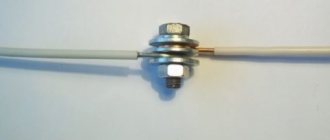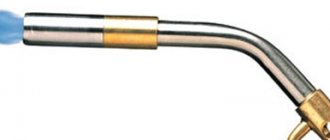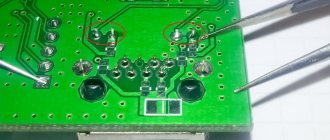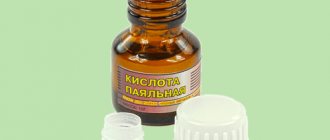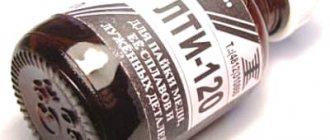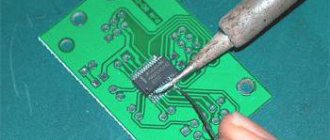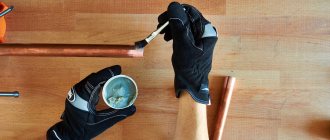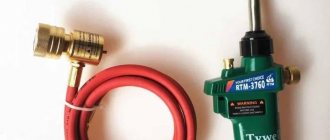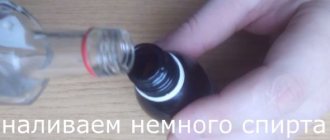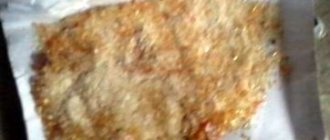The essence of soldering acid
Soldering acid can be used to join surfaces of different materials by introducing molten material between the parts. It's called solder. It has a lower melting point than metal.
The solder should be evenly distributed over the surface of the elements and provide good adhesion to the base. After cooling, it hardens and provides an inextricable connection between the workpieces.
The effectiveness of the presented process depends on the cleanliness of the substrates on which soldering will be applied. Soldering acid is used to prepare the surface of parts. Without it, the process will not proceed satisfactorily, and the required result will not be achieved.
Borax
Borax is another flux that is used in soldering. For these purposes, it is supplied in powder form. It goes on sale packaged in jars or plastic bags.
Borax has a high melting point (about 900 degrees) and a regular soldering iron will not work in any way for its melting and subsequent application, and you can’t even think about soldering radio components using borax!
This flux is used primarily when soldering large parts made of non-ferrous metals, mainly copper pipes of heating and air conditioning systems, bronze, and steel with refractory solders using a blowtorch or gas torch.
Instructions for use
- Immediately before soldering, it is necessary to clean the surface with a file or sandpaper, which will avoid all kinds of contamination.
- Acid should be applied to the adhesion site, for which you can use a brush. Next, you need to cover the structure to be soldered with solder based on tin or its alloy. If the substance does not apply evenly, you will have to repeat the acid treatment again.
- In the next step, carefully solder the surfaces. When working with a heated soldering iron, do not forget about safety rules and try not to clutter the work area with materials that ignite very quickly.
- After completing the procedure, the acid should be neutralized using an alkali, for example, a soda solution, and then rinse the adhesion site to get rid of any remaining acid. In rare cases, acetylsalicylic acid plays the role of a flux, although its use requires a more complex approach.
Soldering technology
The basis of any soldering is high-quality heating of the parts being soldered and then securing them with solder. two types of soldering can be distinguished : using flux or using rosin.
Soldering with rosin
Learning to solder with a soldering iron with rosin is more difficult, but once you master this skill, it will be possible to complete 90 percent of the work.
Let's look at the example of soldering wires to a board. First you need to warm up the wire; to do this, apply the tip of a heated soldering iron flat (it’s better if it’s a tip in the shape of a screwdriver), pressing as much as possible. After a few seconds, the wire with the tip pressed to it is lowered into rosin, which, when boiling, is evenly distributed over all the wire cores. This way the wire is prepared for applying solder. Using a soldering iron tip, take a small part of the solder and apply a thin layer of it to the wire. In this case, you should not get any drops or unaffected areas; ideally, you get the same wire, but in tin.
We clean the soldering iron tip with a metal sponge or cloth and, touching the rosin with the tip, run the tip over the board, leaving a thin layer of rosin on the surface. The surfaces are prepared. Ensuring maximum contact between the wire and the board, we press the tip with a thin layer of solder onto the wire and “stroke” the soldering area several times with a soldering iron for better heating. After this, let it cool and check the contact for strength.
If soldering is carried out correctly, the surface is shiny and the connection has maximum strength. If the surface looks dull and loose, it means that the rules for soldering with a soldering iron were violated and the connection is not so strong. But in some cases, this result is satisfactory.
Soldering with flux
To solder with flux, you just need to take the flux, dip a brush into it and apply it to the surface to be soldered. After this, you can apply solder or solder directly. Despite its apparent simplicity, working with acid has many nuances :
- Each material has its own flux and they are not interchangeable, and in some cases even give the opposite effect;
- You cannot use fluxes that are too active on microcircuits, as they can burn through the metal of the track;
- If you do not remove the flux from the surface after work or do it with the wrong reagent, it will continue to destroy the metal;
- The copper tip of a soldering iron, especially if it is sharpened, is destroyed by acid, and you have to constantly sharpen it.
In addition to knowledge, working with a soldering iron requires accuracy and precision, and having learned how to solder simple parts, it will not be difficult to move on to soldering thinner circuit boards, or, conversely, thick wires, various elements, rhinestones, and subsequently even solder plates together.
What is soldering acid used for?
To perform its direct functions, the presented substance performs a number of actions. It initially cleans the surface of the workpiece from dirt and oxides. In addition to its main function, the acid prevents the appearance of traces of oxidation in the future on various types of parts.
By reducing the surface tension of the solder, soldering acid helps it spread more evenly over the surface. This leads to a reliable connection of parts.
For different metals, suitable types of soldering acid are used. It should also be taken into account that such a substance is a good conductor. Therefore, if it is undesirable for electric current to pass through this path, the electrical flow pattern should be calculated.
What you need to know about flux
Flux is a substance that facilitates the soldering process. It removes oxides before soldering parts and during tinning. Due to high soldering temperatures, the oxidation reaction will accelerate and the oxide layer will appear faster on the soldered surfaces. Flux reduces this process and also wets the surface, which creates a “surface tension” effect and the solder is easier to distribute.
The choice of a soldering station, as well as the search for the necessary flux for the job, directly depends on what specific goal you are pursuing.
For example, low-budget materials are suitable for amateur radio. But for repairs it is necessary to use no-clean substances, especially when it comes to BGA soldering.
Main functions and properties
Before soldering, oxides are present on the contacts. Since the contacts are made of metal, they oxidize in the surrounding air. This chemical process occurs continuously if the metal surface is not protected from air by any layer of varnish or other insulator.
In order to reliably and efficiently solder the contacts to each other, they must first be tinned with solder. From this stage one of the main and key functions of the flux begins.
Main functions of flux:
- quick removal of oxides from contacts during soldering;
- creating surface tension when applying solder to soldering surfaces;
- additional protection of the soldered contact area from the environment (air or moisture, anti-corrosion).
Why is the correct choice of soldering flux so important? When choosing a flux, its parameters and declared properties play an important role.
Parameters and properties:
- residual effects (need to wash off flux residues or not);
- resistance (Ohm);
- working temperature;
- form of the substance (paste, liquid or solid);
- emissions during operation;
- price.
As we can see, there are a lot of these factors. For example, the shape of the flux plays an important role in the job being performed. Liquid rosin is much more practical than solid rosin if you need to solder several dozen wires. But paste-like flux wins over everyone when doing delicate work. It doesn't spread much and is easy to dose. However, you should not use such a flux for soldering wires; it is not economically profitable.
Requirements for fluxes
Since fluxes have different chemical compositions and purposes, the requirements for them may be different. For example, acid is absolutely not acceptable for no-clean fluxes. In some electronics industries, such as security systems, medical and military equipment, the main parameters are their resistance to various external factors during operation. And the quality of soldering is one of the factors of device reliability. Especially when it comes to SMD components and BGA chips.
DIY making
With some knowledge and available materials, it is possible to make soldering acid at home. The set of ingredients is not large; they can be purchased at a hardware store:
- hydrochloric acid in its pure form;
- lump zinc, which is sold by the chemical reagents department; if it is not possible to purchase, a finger-type battery is carefully opened;
- container made of glass or ceramic material.
Soldering acid is made by hand in a certain sequence. It is necessary to fill the container with pieces of zinc, then fill it with saline solution. The actions are carried out in a well-ventilated area; if the solution gets on the skin, you must immediately rinse with running water. After production, the mass is poured into an airtight container for proper storage.
Safety regulations
In the production of soldering acid, hydrochloric and phosphoric acids are used.
They are very active (although phosphorus is weaker) and easily react with many chemicals. When such substances come into contact with the skin, they cause a chemical burn. Even when diluted, their vapors can damage the mucous membrane of the sensory organs.
Taking into account the above facts, safety rules when handling soldering acid include secure storage of the drug, the use of protective clothing and gloves, and good ventilation of the work area.
Making at home
The substance presented is freely available for sale. However, craftsmen still wonder how to make soldering acid at home. This is quite easy to do if you have the appropriate chemicals.
This will require zinc, hydrochloric acid in the proportion of 412 g of Zn and 1 liter of HCl. Zinc is placed in a glass, porcelain or ceramic container. Then hydrochloric acid is added to the laboratory glassware. This should be done very carefully. Hydrochloric acid in the container should not exceed ¾ of its volume.
To understand how to make soldering acid, you should familiarize yourself with the chemical reaction. As a result, hydrogen will be formed (bubbles will come out). When this stops, the liquid will lighten and become clear. After this, it is poured into another container and tightly closed with a lid.
What does it consist of?
In general, soldering acid is called zinc chloride, but the composition of the substances used in practice is somewhat different. Most often, soldering is done using preparations based on hydrochloric or phosphoric acid with the addition of solvents.
Concentrated hydrochloric acid is not applicable because it corrodes the metal. For electronic circuits, acidic substances are not used, soldering using rosin or choosing another inactive flux.
One of the universal types of liquid flux can be considered soldering acid FCA, produced by chemical industry enterprises.
This drug contains:
- zinc chlorides;
- ammonia (ammonium chloride);
- hydrochloric acid;
- water purified from impurities.
At home, soldering acid is made by dissolving zinc in hydrochloric acid. To obtain satisfactory results, you need to know how to solder metals and alloys with soldering acid, and also strictly follow safety rules when working.
Soldering fat.
There is another flux, which for some reason is unfairly rarely used in soldering - solder fat. This type of flux, due to its specificity, is rarely used in everyday life, but is actively used by professionals in the field of electrical equipment repair.
The soldering fat mixture contains rosin, stearin, technical petroleum jelly, zinc chloride, ammonium chloride, and highly purified water. It looks like animal fat and that’s why it got its name.
Depending on the consistency and combination of chemical components, solder fat is divided into two types - neutral and active.
The first contains rosin and stearin and is used to remove oxides for soldering parts with tin-lead solder.
The second is made on the basis of petroleum jelly and paraffin and is highly corrosive and is used for soldering non-ferrous metals and heavily rusted iron. Due to its high ability to cause corrosion, it cannot be used for soldering printed circuit boards.
And from this video you will learn something more about choosing a flux in other aspects.
Other soldering features
At the learning stage, many beginners have a question: “what is solder and flux.” Solder is a common form of low-melting metal that is required for successful soldering of radio circuits, electronic components, and jewelry. Most often, solder is made from tin, but in its pure form such metal is not cheap, so it is used only for tin-plating and soldering of utensils, which are used for storing and preparing food. If it is necessary to solder wires and electrical circuits, the tin-lead solder option is used.
When performing soldering work, you may need the following tools and accessories:
- stand for soldering device;
- side cutters;
- pliers;
- tweezers;
- stationery knife;
- vice;
- desoldering pump or copper braid.
The soldering process itself includes several steps:
- Cleaning the selected area to a shine.
- Dipping the soldering iron tip into rosin for more effective cleaning.
- Firmly pressing the connected elements together.
- Then it requires applying a soldering iron with a small amount of solder at the end to the junction of such parts.
- Next, you need to run the soldering iron tip along the part or wire, doing this as quickly as possible to avoid burning out the rosin on the tip.
- The soldering area should be thoroughly heated so that the rosin, when melted, covers the entire surface of the part, and the solder fills the gap between the parts.
- Be sure to remove excess solder with a soldering iron or desoldering iron. It also wouldn't hurt to use braid.
If all operations are carried out exactly according to the established rules, the hardness of the solder will become maximum, and its distribution will be uniform.
If during the solder solidification stage the soldered parts move from place, most likely the soldering is not good enough. To avoid such a course of events, it is enough to learn how to avoid making many mistakes.
General rules of application
For soldering, tin-lead solder (PLS) is usually used. Its main component is always tin, and lead is added in proportions, depending on which the solder acquires the properties necessary for soldering.
Lead makes the material softer and more fluid, while tin provides strength to the hardened joint.
Despite the presence of lead, the fluidity is often not enough to overcome the surface tension forces in a drop of solder, and with little adhesion to the metal surface, the solder remains in the form of a drop that does not want to stick to the parts.
If the surfaces are first cleaned of oxides, the adhesion force will exceed the forces of surface tension and the solder will spread over the surface, ensuring good adhesion, that is, sticking.
To clean the surface, it is mechanically cleaned using a file or sandpaper and soldering acid is applied. It can be applied with a small brush made of natural materials or with a small spatula.
Often the composition is contained in plastic bottles with dispensers that are convenient to use. The flux must cover the entire surface to be soldered, otherwise the solder will not stick well to it.
During contact of the heated solder with the surface, the soldering acid evaporates, but its presence is no longer required. After the solder is applied, it itself performs a protective function, preventing oxidation. This process is called tinning.
Both soldered workpieces are subject to tinning. After tinning, you can easily connect them by applying additional solder to the joint.
Of course, when soldering with a soldering iron, the tool must also be clean and the tip, made of copper, must not contain oxide films. To do this, the tip must also be tinned first by dipping it while heated in soldering acid and applying solder to it.
Use as a flux
The main function of flux materials is to remove dirt and oxides from the surface of parts to be soldered. It is also necessary to ensure maximum wettability of the solder. Otherwise, adhesion will be weak and soldering will be ineffective.
Free orthophosphate not only removes oxidized products, but also forms a film of phosphates that are well wetted by solders. Soldering after this treatment is successful.
However, you need to act wisely and carefully. Excess acid flux can provoke subsequent destruction of metals at the soldering site. All excess must be carefully removed. The work area can be cleaned by normal rinsing with water.
Soldering utensils
How to install a socket with your own hands correctly
Buckets and pans with holes no more than 5-7 mm in diameter are recommended to be soldered without using a soldering iron with POS-60 solder. Leaky places on the dishes can be reliably soldered. To do this, the holes are carefully cleaned with sandpaper from the inside of the container. The hole along the edges is given a conical shape, the cleaned areas are treated with a solution of soldering acid with a brush.
In order to prevent solder leakage from the outside, all bottoms or individual places where holes need to be soldered are covered with thin tin plates. Powdered solder and rosin are poured into the cleaned holes from the inside. The soldering areas are heated over an open fire until the solder melts and fills all the cracks.
For radiators, stripping and soldering are carried out from the outside. To prevent solder from leaking inside, the hole is covered with a plate of tin, galvanized iron, or can be replaced with copper or brass. The choice depends on the material from which the radiator is made. Homogeneous metals and alloys that are similar in composition are easier to solder.
After completing the soldering process of radiators, the internal and external surfaces are thoroughly washed with an alkaline, soapy solution in order to prevent the effect of acidic components on the metal.
Bottle with flux for soldering aluminum
When it is necessary to solder aluminum parts, special solders are used:
- 4:1 mixture of tin and zinc;
- 30:1 mixture of tin and bismuth;
- 99:1 tin and aluminum powder.
The sequence of surface treatment is the same as for preparing iron utensils. In order to properly solder aluminum, rosin is added to the powder, but the melting point must be above 500ºC. It is recommended to stir the solder in the hole, using a thin copper soldering iron tip.
Use of tin for soldering
Different materials can be used for soldering metals, but connecting elements with tin is much easier and more convenient.
Tin can be used to connect parts made of stainless steel, aluminum, copper, and its alloys.
Tin is melted at a temperature of 2500; for this purpose, various heating devices can be used:
A soldering iron is a device with a metal working part and a plastic handle, and can have a variety of tips.
Heats up with a gas burner.
Electric soldering iron - the set includes replaceable tips of various sizes and shapes. The structure is assembled from a soldering rod and a heating coil, which can have different heating power.
Gas burner - a portable design is a container with a handle and a nozzle for creating a fire of varying intensity.
How to properly solder tin on stainless steel?
For soldering stainless steel elements, it is recommended to use active soldering acid, for example, zinc chloride or phosphoric acid.
Flux is applied to the surface of the stainless steel right before soldering begins. The tip of the soldering iron is tinned with molten tin and the surface of the stainless steel begins to warm up well.
Read also: What kind of machine is needed for 6 kilowatts
The procedure is repeated until the coating becomes uniform. During the soldering process, you can use rosin, which will make the surface smooth by removing oxide from the solder.
After soldering the stainless steel is completed, the product is washed from acid residues with soapy water. Excess rosin is easily removed in cold water.
It is worth noting here that high-quality soldering will have a uniform and smooth surface.
How to properly solder aluminum with tin?
Before soldering aluminum, the surface is cleaned using emery cloth, then the work area is degreased with an organic solvent.
To solder aluminum you will need a soldering iron with a power of 100 W, as well as solder made of tin - 95% and bismuth - 5%. Stearic acid can be used as a flux.
Since aluminum products are difficult to solder due to the rapid formation of an oxide layer after stripping, it is necessary to fill the surface to be joined with hot rosin.
Then, use a soldering iron tip to take the solder and transfer it to the working part treated with rosin.
After tinning the aluminum in this way, it will become easier to solder the surface; if necessary, even copper wires can be soldered to it.
Every person who has had to work with radio electronics has repeatedly used a soldering iron to solve their problems, so he knows what the operating principle of such equipment is. But due to the unpleasant odor emitted when processing a structure using classic solder, as well as significant difficulties at different stages of operation, this technology is not in great demand and has a number of simpler analogues.
How to wash off acid after soldering?
According to the strength of their effect, acid fluxes can be divided into active and inactive. What are their features? Examples of active ones: zinc hydrochloride, orthophosphoric. Fluxes of this type are used when soldering copper, iron, nickel, carbon steel or aluminum. They remove oxide well, but, remaining on the surface of the metal, cause corrosion. After finishing work, they must be neutralized and washed off with a solution of soda ash or water and soap. In some cases, it is recommended to use alcohol or acetone.
Neutral fluxes, for example. oleic, used for soldering radio components and printed circuit boards. They are safe in terms of corrosion and do not require rinsing. If necessary, flux residues are removed with alcohol, acetone or water.
Soldering acid: what do you need to know about this procedure?
Soldering is a complex physical and chemical process that results in a reliable and durable connection (fastening) of any metal parts. Soldering acid is an indispensable soldering attribute that ensures high-quality connection of parts.
Scope of application
Phosphoric acid is used for soldering as a flux. The substance can also be used to clean metal surfaces from rust. Thanks to it, the treated metal surface is covered with a protective film, which prevents the material from further corrosion.
Description of the acid
Phosphoric acid is inorganic. The composition has the chemical formula H3PO4 and is colorless hygroscopic crystals under standard conditions. When heated to a temperature above 213 degrees. The composition of the substance turns into pyrophosphoric acid H4P2O7. The composition is highly soluble in water.
Specifications
Externally, the substance is a colorless or light yellow solution. It is worth noting that the composition of the substance may have a cloudy tint. The mass fraction of zinc chloride included in the composition, as a percentage, is a minimum of 50% and a maximum of 0.005%. The mass fraction of insoluble residue is 0.001%, and the mass fraction of ammonia is a maximum of 0.5%. Maximum pH – 2.9%.
Application of the substance
Applications of the substance are the connection of carbon and low-alloy steels, nickel (alloys), copper (alloys) at a temperature of 290-350 degrees. C. The mechanism of action of the substance is the dissolution of the oxide film of the metal, as well as solder and further loosening, floating to the surface of the flux.
A protective film of the substance is formed in the area of the cleaned metal, preventing the appearance of oxide films. The remaining substance is washed off with water.
Precautionary measures
Phosphoric acid is an explosion-proof and fireproof product of the chemical industry. Storage must comply with all required safety standards: the composition is stored in a tightly closed container, away from exposure to sunlight, heat, and children. Before starting soldering, it is necessary to open the windows wide to create through ventilation of the room where soldering will be done. After soldering is completed, the room should be thoroughly ventilated for half an hour.
During soldering, it is necessary to use personal protective equipment (PPE) for the respiratory organs, eyes, and skin of the hands. If the substance gets into an open area of the body, for example, on the hands, the area of the body is thoroughly washed with plenty of running water for ten minutes (preferably with soap). If the substance gets into the eye area, they should be rinsed under running water for a longer time.
Storage and packaging
Orthophosphoric acid is stored at temperatures ranging from -25 to +35 degrees. C. Guaranteed shelf life is six months from the date of manufacture. Orthophosphoric acid (soldering acid, 85%) is often sold in containers of 5 to 10 milliliters.
External qualities, as well as technical characteristics of the substance
Hydrochloric acid is a solution of hydrogen chloride in water. The chemical has a colorless or yellowish tint with a pungent odor. The product of the chemical industry is a caustic and non-flammable liquid that has the property of dissolving most known metals, as well as their oxides. The following materials are stable in it: porcelain, fluoroplastic, graphite, ceramics, glass.
Hydrochloric acid smokes when exposed to air. Can be mixed with ether, benzene. The substance has a corrosive effect on the surface of metals, as well as highly toxic properties (corrodes muscle tissue and skin).
Soldering using acid
The soldering process requires the use of special fluxes - substances that help the solder spread over the soldering area and create a high-quality metal connection. The main fluxes are rosin and acid.
Rosin is mostly used during soldering of silver and copper, while the use of acid is preferable for joining more complex materials.
The choice of substance depends entirely on the type of metal being fused and its alloys. For example, to solder iron it is necessary to use so-called soldering acid - a solution of zinc chlorate; Soldering stainless steel requires the use of phosphoric acid, as well as specialized multicomponent fluxes. It is worth noting that acid is not suitable for soldering printed circuit boards and other similar parts.
If you are determined to use acid, it can be purchased in finished form (paste). It is worth knowing that the substance can be made independently.
DIY acid:
- You need to take 100 milliliters of hydrochloric acid;
- Put pieces of zinc into the acid (zinc can be obtained from batteries);
- Next, a chemical reaction will occur, as a result of which hydrogen will be released;
- After the release of hydrogen bubbles, the composition of the solution must be infused until it becomes transparent;
- Carefully pour the solution into a bottle prepared in advance;
- Soldering acid is ready for use.
Types and uses of soldering acid
[Acid for soldering is necessary] if the use of rosin does not allow the necessary elements to be properly soldered together. The use of soldering acid for soldering helps remove the oxide film layer from the surfaces being soldered and makes it possible to properly prepare them for joining.
As a rule, rosin is used to prepare copper parts for soldering with your own hands. But soldering acid is used for tinning not only copper, but also its alloys - bronze and brass.
And also for stainless steel, precious and ferrous metals, aluminum and nickel, even for soldering cast iron.
Purpose
To prepare parts for applying solder, it is necessary to clean them of particles of foreign materials - dust, sand, water. In addition, it is necessary to remove the oxide film from the surface, which is present on almost all metals.
And if the first condition is easy to cope with mechanically, using a file, needle file, or sandpaper, then the second condition is difficult to fulfill without the use of chemical compounds - an oxide film very quickly appears on the surface of the metal.
Substances that remove film and prevent the formation of a new one are called fluxes, and the most effective of them is soldering acid. It is an active flux, that is, during soldering it chemically affects the composition of the metal surface.
Professionals never question why soldering acid is needed; they know very well that very often it is impossible to complete the assigned tasks without it.
Soldering acid is used for the following metals:
- copper and its alloys;
- nickel;
- iron;
- structural steel;
- alloys of non-ferrous metals.
If copper or brass parts are successfully soldered with borax, then it is often possible to solder aluminum or steel workpieces to each other only using soldering acid. Upon completion of work, the active flux must be washed off with water containing a small amount of alkali.
You can buy acid in stores, or make it yourself using chemical reagents. Although purchasing raw materials can be more expensive than ready-to-use flux.
Benefits of acid
Each composition has certain advantages, soldering accessories are no exception.
Soldering aluminum with acid
Main positive aspects:
- The convenience of the process, soldering allows you to process a contact in a hard-to-reach place due to its fluidity properties.
- Increased aggressiveness allows you to destroy oxide films and rust deposits. Typically, oxide films are not visible to the eye, so the connection must be processed.
- There is no need to worry about the subsequent formation of an oxide film; soldering acid counteracts this, even mechanical stress.
- The variety of metals with which it is possible to perform operations allows the solution to be used for every job.
Phosphoric acid for flux production
The second common type of soldering acid is phosphoric acid - H3PO4. It also ideally removes oxide film from metal surfaces and prevents its renewal.
Reference: H3PO4 (orthophosphoric acid) is a component of many anti-corrosion compounds for metal processing.
To carry out high-quality soldering of elements made of nickel or chromium, such acid is used undiluted. Moreover, the composition prepared using it includes 1/3 of ethanol or ethyl alcohol.
The share of orthophosphoric acid is 32%, and 6% is rosin.
In other acid compositions used for tinning and soldering, the proportion of acid can reach 100%.
Very often, H3PO4 is combined with zinc chloride, and its mass in the finished flux can reach 50%.
The use of phosphoric acid is not limited to soldering nickel alloys; it is used to connect elements made of stainless steel, copper, aluminum and low-alloy steel.
Orthophosphoric acid is a component of the classic active flux "F-38 N", the use of which makes it possible to solder copper alloys and pure copper, various steels and chromium-nickel alloys.
“F-38 N” is an excellent option for carrying out the work process in hard-to-reach places; it has the ability to protect welded elements from corrosion.
The components of “F-38 N” are: diethylamine hydrochloride and 25% phosphoric acid.
Orthophosphorus soldering composition is characterized as fire and explosion-proof. It is recommended to store and use the product with all precautions.
In case of contact with skin, rinse for at least 10 minutes under running water.
Precautionary measures
Aggressive properties require a special approach to safety precautions. Storage is carried out in original packaging, protected from direct sunlight.
It is better to carry out work with good ventilation, using the necessary protective equipment.
The skin reacts negatively to aggressive substances. If it gets on your hands, wash it immediately with water and laundry soap. Inhalation may cause oral irritation, and if it gets into the eyes, seek professional help.
Fluxes overview
Let's look at the most popular fluxes for soldering radio components and metals.
Rosin
Rosin is the simplest flux. Some beginners get confused in definitions and separate the concepts of “flux” and “rosin”. It is the same. Rosin is a flux. Extracted from tree resin.
An all-time classic. Among the advantages are accessibility, low emissions of harmful substances and low cost.
Disadvantages: poor tinning of highly oxidized contacts and insufficient surface tension of the solder.
Rosin can be safely used for DIP soldering of radio components, wires and homemade printed circuit boards.
Another type of rosin is liquid.
It is easiest to apply it to the board. However, it has a significant drawback. It's very sticky. Try not to spill it. In addition, you should not leave the bottle without a lid for a long time.
Liquid rosin, when soldering wires, spreads well over the entire area, which much better ensures the distribution of solder during soldering.
Sold with or without a brush.
And another type of liquid rosin is FKET.
In general, this is the same rosin, only the proportions of the substances may be different.
Liquid rosin has the same uses as solid rosin, but it’s also easy to apply.
Don't even try to fill the syringe with liquid rosin. It will dry in the needle in just a couple of minutes.
They also sell so-called rosin pencils. On the one hand, they are convenient to use for soldering solar panels. On the other hand, their main disadvantage is that they leak. Such “pencils” are not recommended for purchase.
Soldering fat
It differs from rosin in composition.
Fat is softer and easier to wash off. The advantages and disadvantages in terms of soldering are generally the same as those of rosin. However, grease is much easier to remove from the board. In addition, alcohol rosin can leave marks on clothing, and its residue will stick to surfaces. But fat doesn’t have that.
It is also divided into active (contains acid) and neutral. Active can be applied with toothpicks.
The disadvantages of fat include the fact that when heated, it spreads greatly. This can cause difficulties when applying it to solder joints and parts to be soldered.
LTI-120
An example of a good activated flux.
Ideal for tinning circuit boards, parts, and even some aluminum parts. By the way, some radio amateurs solder headphones with acid due to the fact that the wires are poorly tinned. But in vain. LTI-120 copes with this perfectly.
The quality of LTI-120 greatly depends on the manufacturer.
Soldering acid
Do not use for soldering radio components. Only for soldering carbon steels, copper, nickel and their alloys. And then only in case of urgent need.
Be sure to rinse off after soldering.
Orthophosphoric acid
It is used for cleaning rust, as well as during soldering of highly oxidized compounds and metals. A last resort if all other fluxes fail.
Be sure to wash it off.
Acetylsalicylic acid
For old-school radio amateurs, aspirin served as a good flux that could be used to tin some heavily oxidized areas of soldering. Soldering with such substances is not recommended. The emissions are very toxic. In addition, thorough cleaning of the board after soldering work is mandatory.
F-38N
For soldering nichrome, constantan, beryl and aluminum bronzes. And also suitable for corrosion-resistant steels. Very highly active.
Residues of F-38N must be washed off after soldering.
Rosin-gel
Among the advantages, the following can be noted: it does not dry out, has approximately the same properties as LTI-120, and does not need to be washed off. And this gel is not expensive.
TT indicator flux gel
It is not recommended for purchase, especially if you will be repairing equipment (for example, soldering USB connectors or changing microphones).
If the flux residues do not discolor after soldering, they will destroy the contacts. Therefore, if you decide to solder with this flux, then do not forget to monitor its condition after soldering.
And it is advisable to wash it off, even though the manufacturer writes that there is no need to wash off its residue after soldering and changing color.
Flux MARTIN
An excellent option for BGA soldering. It smokes little and solders well.
Its main drawback is its huge price. There is no point in buying such a flux for beginners. When training, you will waste a lot of flux.
Domestic option for BGA - Interflux (interflux) IF 8300
Excellent quality, does not require rinsing. As in the case of MARTIN, there is the same drawback. This is a high price.
RMA-223
This is a good quality flux for SMD and BGA mounting, slightly inferior to MARTIN-y. At the same time, it has an acceptable price for both radio amateurs and service providers. .jpg” class=”aligncenter” width=”529″ height=”172″[/img] Does not require washing off residues after soldering. And most often it is faked.
Original fluxes VS fakes
Soldering flux manufacturers offer many different options for their products. The final price is determined by the substances used, manufacturer's warranties, research and testing, as well as soldering safety.
There are manufacturers that have been producing soldering fluxes for many years and selling them all over the world (for example, Amtech). And there are also fakes of such fluxes. Usually, counterfeits are sold in radio stores and online sites. Such fluxes are much cheaper than the originals. If the original costs 7,000 rubles per 100 ml, then a fake can cost 1,000 per 100 ml, or even 500. Counterfeits can be produced underground, which in turn affects the quality and safety of the finished product.
Is it dangerous to solder with fakes? Let's start with how much time you devote to soldering and what guarantees for work are needed. For example, if you are a beginner and do your own soldering for a couple of hours a week, then any paste flux will do to start with. However, you should not take very cheap fluxes. For example, with AliExpress 5 tubes at a price of 100-200 rubles is not the best choice. You will not get anything other than an incomprehensible mixture and terrible soldering quality for such a price.
If you think that soldering with expensive fluxes is absolutely safe, then this is far from entirely true.
Some fluxes contain various activators, which, if they come into contact with mucous membranes, inside the body, or with excessive soldering in an unventilated area, can cause irreparable harm to health. Therefore, when soldering, do not forget to ventilate the room and take breaks. The difference from fakes is that the manufacturer writes the true composition of their products. You can at least be sure of what exactly is included in the flux. It is very difficult to check the composition of a fake on your own, since the available information cannot be reliable. Review article on fake soldering fluxes on Habré.
Good fake RMA-223
This version of flux was purchased at a specialized store for repairing mobile equipment.
In general, it solders both SMD and BGA parts well. There are no pungent odors or heavy smoke from it during soldering.
Bad fake RMA-223 from AliExpress
On AliExpress they often sell these tubes with supposedly RMA-223. And the price is usually no more than a few dollars for 4 tubes.
This is a disgusting copy. It collects solder poorly, smokes and has an incomprehensible composition. Compared to this flux, even ordinary solder fat looks like a high-quality material for BGA and SMD soldering (although it is almost unsuitable for this).
For comparison, photos of different “copies” of RMA-223.
At a minimum, the tube formats, their names and colors are visually different, not to mention the quality of soldering. Don't buy cheap knockoffs that cost less than $4. They do not wet the solder well and smoke a lot.
How to make your own flux
There are many recipes on the Internet for preparing a homemade version of flux, but in any case, all of them are inferior to their factory counterparts in all respects, including price.
How to solder without acid
To solder efficiently and correctly, just follow simple rules:
- Do not overheat the soldering area. If it seems that tinning and melting the solder is going slowly, it is better to try another tip, try heating the air with a hairdryer to one hundred degrees (on top of the hairdryer, near the soldering area). Under no circumstances should you increase the temperature on the soldering iron to 400 degrees, this will only worsen the situation. Solder at such temperatures begins to evaporate rather than melt, let alone flux.
- Assess the situation. For example, some parts or connectors cannot be tinned well without heating. In especially severe cases, you can even lightly walk over the contact with the softest and most gentle sandpaper. There is such a problem with homemade boards when they are not soldered for a long time after production. Copper traces are plated with copper and are more difficult to tinn than before.
- Safe soldering. Soldering should only be done in a ventilated area. Even the products of rosin evaporation are not very useful, let alone other fluxes, especially soldering acids. When soldering, you must maintain a distance, otherwise a drop of solder may accidentally get on your skin or mucous membranes.
Advantages and disadvantages of acid
- Good tinning of oxidized surfaces;
- Low price.
It removes oxides perfectly, is available in any radio store, and acetylsalicylic acid is available in a pharmacy.
- The products released during acid soldering are very dangerous (especially if they come into contact with the skin or mucous membranes);
- Residues of acids at the soldering site can damage the connection over time if they are not washed off in time;
- Acid has high electrical conductivity - and this is a short circuit.
Active flux has major disadvantages that are not equal to the advantages.
Radio amateurs most often solder radio components, wires, and printed circuit boards. All this is well soldered with ordinary rosin. At most, a small oxide film may form on the parts due to the oxidation reaction in air, but it is not as critical as oxides from water.
Soldering without a soldering iron
Sometimes when soldering using soldering acid, you can do without a soldering iron. One of these methods is used, for example, when soldering twisted wires during electrical installation work on electrical wiring.
In this case, flux is applied to the twist with a brush, and for a better effect, the twist is dipped in a small container with acid. After this, the twist is immersed in a container with molten solder and held for about 1 minute so that the wires warm up well and the solder penetrates to all points of their surface. This soldering provides excellent electrical conductivity when connecting wires.
After soldering, it is necessary to remove the remaining soldering acid from the joint in order to avoid metal corrosion and destruction of the joint in the future.
It must be remembered that when installing printed circuit boards of electronic circuits, when soldering electronic components of radio devices, it is not recommended to use soldering acid, since very thin conductive traces of the boards can be damaged. When applying flux, soldering acid can dissolve them.
Rosin
Rosin is made from the resin of coniferous trees and is a solid substance, somewhat reminiscent of amber in color.
For the convenience of users, manufacturers package it in various containers.
May also be sold as a ready-made solder.
It is very convenient to use such solder, since melting solder and flux simultaneously cover the joint of the parts being soldered, reducing the process time.
Rosin is used mainly when soldering electrical products, such as wires, radio components, microcircuits, since it does not oxidize at all over time, which contributes to long-lasting and durable connections.
Necessary procedures before work
Before soldering, as before any other work, it is necessary to perform a number of procedures that contribute to a better result of the work:
- Before joining metals to each other, they must be cleaned of dirt and oxide film that prevents the substance (hereinafter referred to as “solder”) from spreading over the surface. This condition must be observed, otherwise the solder, like a ball, will concentrate in one place and will not spread.
- For the most successful spreading of solder over the material, it must be treated with a flux solution, which will protect the metal from corrosion and oxidation. The most common flux is rosin. This "household" flux (more often used for household work than for industrial purposes) is used for alloys of the common metals: copper, brass and aluminum. In the case of iron, cast iron and steel, so-called pickling acid is used for soldering.
How to choose a flux for soldering.
First you need to understand what flux is. Flux is a substance that allows hot liquid solder to wet solder joints. After the solder cools, a solder joint forms. If you do this without flux, you will end up with a cold solder joint that may fall off immediately or over time. All fluxes exhibit acidic properties when hot. Many are acids at ordinary temperatures, for example, orthophosphoric acid, soldering acid. The higher the acidic properties during soldering, the stronger the flux, the better and faster the soldering will be. Here is a list of fluxes we produce in order of increasing activity. The higher the number, the higher the activity of the flux.
- Rosin
- Liquid rosin
- Flux paste
- Liquid rosin LUX
- rosin gel
- rosin gel active
- LTI-120 LUX
- LTI-120
- Glycerin hydrazine flux
- FIM
- F-34
- Soldering acid
- Orthophosphoric acid
- F-64
Does this mean that you can take the strongest flux and solder everything? Unfortunately no. For example, the strongest flux we produce is F-64 - a flux for aluminum and it has the appropriate chemistry for this. But for soldering copper, “Orthophosphoric acid” will be the strongest. But otherwise, if you don’t have enough flux activity, you need to look at this list and take the more active one, next by number. A safety list of residues will also help you avoid choosing too active a flux:
- Soldering acid
- Orthophosphoric acid
- F-64
- F-34
- FIM
- Glycerin hydrazine flux
- LTI-120 Lux
- LTI-120
- Liquid rosin LUX
- Rosin gel Active
- Rosin gel
- Liquid rosin
- Flux paste
- Rosin
The highest number is the safest flux. You must understand that by choosing a more active flux, you increase the risk of oxidation of the soldering area. But even cooling rosin can create a greenish coating on polished copper.
Choosing a flux for soldering
1. Soldering small radio components onto a printed circuit board.
If all the parts are tinned, then Liquid rosin or LTI-120 will suit you. There is no need to remove the residue, but make sure it dries as... liquid residues may have megohmic resistance. Liquid rosin can be replaced by flux paste; due to its paste-like form and non-drying base, it has some advantages. Residues are harmless but difficult to remove. A modern means of replacing liquid rosin and flux paste is Rosin gel. Having all the advantages of both fluxes, it, consisting of modified rosin, is as easily removed as Liquid rosin, and at the same time has a higher activity. A gel-like replacement for LTI-120 is Rosin gel Active. In structure it is a rosin gel and in activity it is comparable to LTI-120. Rosin is used quite rarely today for soldering radio components. Steels are widely used LTI-120LUX and Liquid rosin LUX due to their fashionable property of absolute water washability. For soured radio components, it is better to use LTI-120 or Rosin gel active, as well as the new fluxes LTI-120LUX and Liquid Rosin LUX.
2. Soldering small radio components onto a printed circuit board.
Rosin activated fluxes: LTI-120 or Rosin gel active cope excellently with large-sized radio components. Glycerin hydrazine flux has also proven itself very well, but after it it is necessary to clean the soldering areas with hot water from glycerin residues. Residues of Glycerin hydrazine flux do not oxidize soldering and for parts not related to electronics, residues are acceptable, but residual mega-ohm resistances are possible on the printed circuit board.
3. Iron, copper, brass. Small parts.
When the parts are small and you don’t have to resort to acid fluxes, use Glycerin hydrazine flux or LTI-120. Water-containing LTI-120LUX and Liquid Rosin LUX can also cope with this task. Flux paste often helps. Sometimes what is more important is not the activity of the flux, but how long it takes for it not to evaporate at the soldering temperature, since the part still needs to be heated and during this time the active, but quickly evaporating flux will evaporate. This is where water-based fluxes, such as LTI-120LUX and Liquid Rosin LUX, Hydrazine Glycerin, come in handy. In addition, non-drying fluxes Rosin gel Active and flux paste can be very useful for the same reason as water ones. Unlike water-based fluxes, they do not hiss and melt beautifully.
4. Iron, copper, brass, galvanized iron. Massive details.
In such cases, take acid fluxes: Soldering acid, Fim, Phosphoric acid. Acidic fluxes begin to work instantly and it seems that the part needs to be heated less. This is an illusion, but it reflects how much easier parts can be soldered when using acid fluxes. Orthophosphoric acid and soldering acid are more or less similar in activity. FIM flux has less activity. They differ in their residues after soldering, and for such active acid fluxes this is very important. The residues of orthophosphoric acid begin to interact with metals first. These are dark gray deposits of phosphates. But these residues are quite stable and create a strong phosphate film that protects the metal from oxidation. Suffice it to say that this acid is used in auto repair shops instead of galvanizing, which is unreliable in garage conditions. Phosphate coatings obtained in this way reliably protect iron from rust. Cl of soldering acid takes a little longer to manifest itself. The residues are metal chlorides that form unsightly oxides. If it is iron used outdoors, then it can become a catalyst for rust. And finally FIM flux. Its remains, due to the low content of orthophosphoric acid, are slightly corrosive, so it is well suited for clean but active rations. A question that very often arises among people who solder with active fluxes: What to do when you are soldering a product and the last seam closes the container? Some of the flux will remain inside and it will no longer be possible to remove it. The answer to this question was found in Soviet times when sealed casings of infrared instruments for satellites were sealed. The last seam was made exclusively with orthophosphoric acid. The quantity was selected exactly as needed for soldering. The flux was applied with a pointed wooden stick soaked in acid. The sufficiency of flux was determined by how much flux was sprayed. Control autopsies were carried out after climatic tests. On the inside of the soldering joint, where removal could not be carried out due to inaccessibility, flux residues formed persistent phosphate films that did not affect anything.
From everything I said, it’s clear that the residues need to be removed. And if in the case of orthophosphoric acid it is necessary to remove residues for aesthetic reasons, then in the case of soldering acid this will prevent further troubles. How to remove acid residues? Ideally rinse off with plenty of water with a brush. It is better to use Flux Remover after this, which neutralizes the acidity of acid flux residues. Wiping with a damp cloth is also widely used. Usually two or three movements are enough. But you need to wipe it, not like you brush crumbs off a table, but with a little effort so that the soldering shines. Removing rosin fluxes is best done with a “Rosin Solvent,” but you can use most solvents sold in household goods or alcohol.
Pros and cons of soldering acid
The solution has a number of undoubted positive properties:
- eliminates almost all oxides formed on metal structures;
- prevents the re-formation of oxidative plaque;
- used in a dissolved substance, but can also be used in concentrated form;
- simple technology of use, characterized by a quick effect on the metal.
Of course, there are also disadvantages:
- Not all materials can be soldered with acid, since the substance is very aggressive;
- the acid retains its properties for no more than six months, and during this time it is necessary to follow storage rules;
- store in special containers in rooms with excellent air circulation - direct contact with the substance without protective equipment is very dangerous for the human body.
Soldering acid is widely used when soldering miniature small objects, as it is available in liquid form.
Features of metal soldering
For a quality connection, it is important to follow certain instructions; the work differs from soldering with ordinary solder.
Soldering acid is used in many cases, before starting work it is important to follow the steps:
- Coarse dirt and metal oxidation are cleaned with sandpaper or a file.
- The flux is carefully applied using a brush or a special dispenser; the solution is in a liquid state, so it easily spreads over the surface.
- Tinning occurs with the application of solder, the products are fastened together.
After completing the process, it is necessary to remove the remaining solution. This can be done with ordinary soapy water or a solution of soda.
